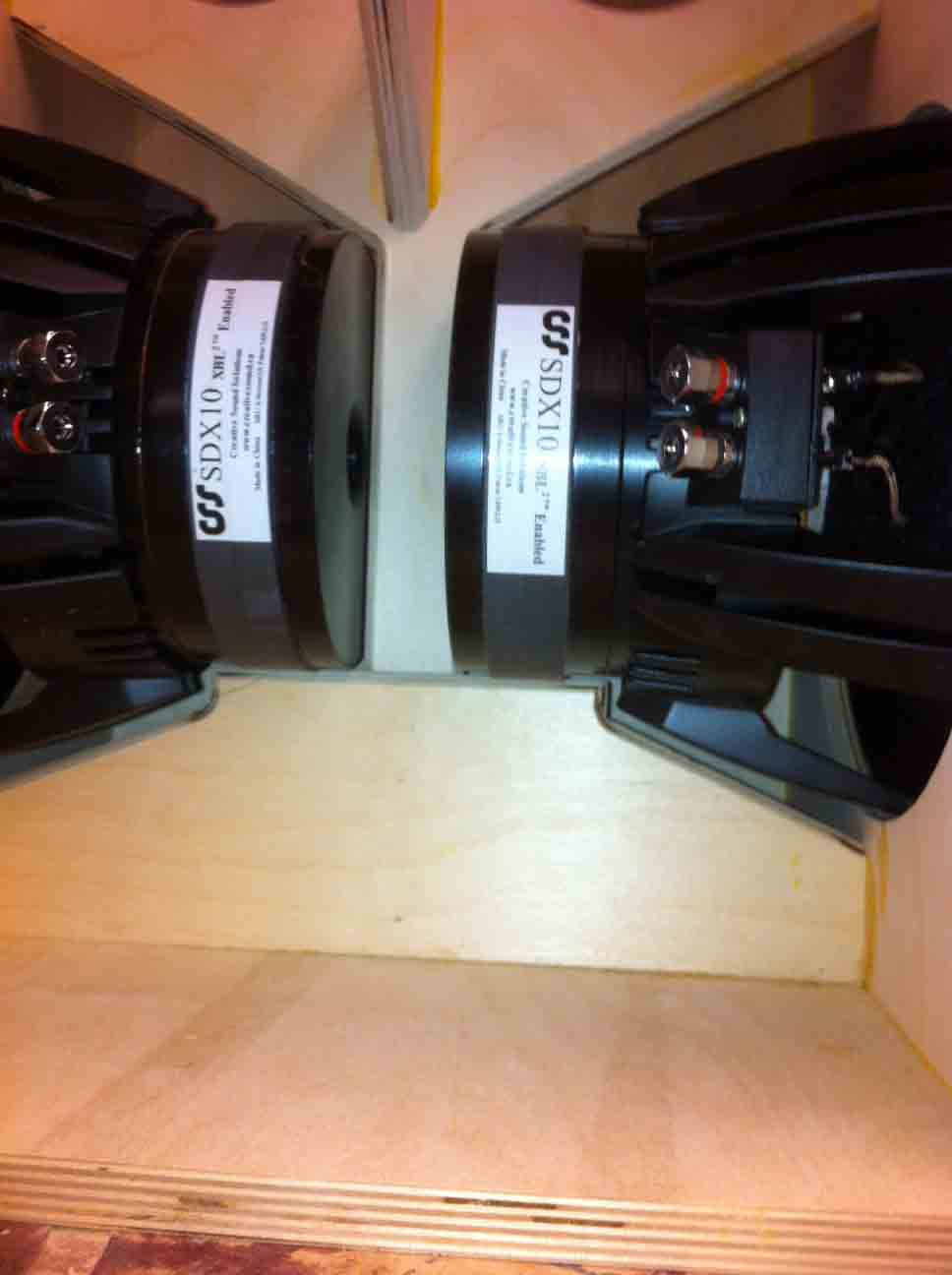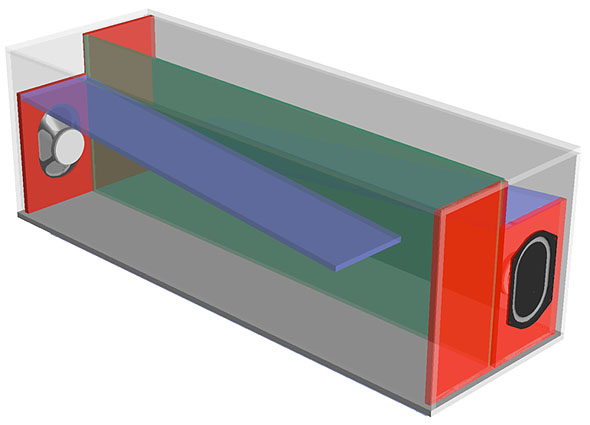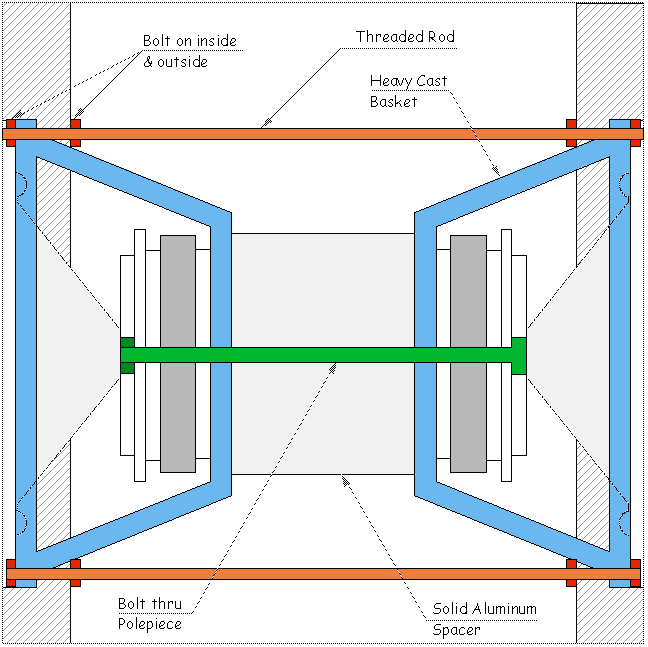Hi guys!
I don’t wanna get redondant with my post but I was reading my other thread about my living room subwoofer and I wanted to get a little informations on slot loaded-ish subwoofer.
So I designed this living room table subwoofer. But I’m not sure how to handle/make the grille
Here’s the original design with the grille:

Or I can go east and make a fabric grille with a frame like this under the fabric:

But I feel like the grill would be very heavy. And as I want to not have visible hardware (as much as possible) and want to protect the woofer from everything that can happen in a living room with a 2yo.
While wanting to keep vibrations to a minimum, I sketch this version:


I have 2 Dayton um15 for the subwoofer. Will be Powered by 2 behringer inuke 6000.
So I wanted to have feedback / advice / opinions / facts on the slot load design.
The second version could have 1-2-3 slots depending. As long as the top stays solid for table purpose.
What would be the minimum distance between the two driver in order not to be considered a slot and for not having any “down side” of such design?
Should I stick to the 1st with grille?
Table is 16.5x16.5x40 external dimension.
Pannel are already cut in Baltic birch for the first design, but I have some left so I can make minor adjustment for the slot load design if it’s best.
I’ll gladly add any forgotten information if you guys have question.
Thanks!
I don’t wanna get redondant with my post but I was reading my other thread about my living room subwoofer and I wanted to get a little informations on slot loaded-ish subwoofer.
So I designed this living room table subwoofer. But I’m not sure how to handle/make the grille
Here’s the original design with the grille:
Or I can go east and make a fabric grille with a frame like this under the fabric:
But I feel like the grill would be very heavy. And as I want to not have visible hardware (as much as possible) and want to protect the woofer from everything that can happen in a living room with a 2yo.
While wanting to keep vibrations to a minimum, I sketch this version:
I have 2 Dayton um15 for the subwoofer. Will be Powered by 2 behringer inuke 6000.
So I wanted to have feedback / advice / opinions / facts on the slot load design.
The second version could have 1-2-3 slots depending. As long as the top stays solid for table purpose.
What would be the minimum distance between the two driver in order not to be considered a slot and for not having any “down side” of such design?
Should I stick to the 1st with grille?
Table is 16.5x16.5x40 external dimension.
Pannel are already cut in Baltic birch for the first design, but I have some left so I can make minor adjustment for the slot load design if it’s best.
I’ll gladly add any forgotten information if you guys have question.
Thanks!
Last edited:
The second one makes more sense. Both need more substantial connection to maximize the active cancelation. And the boxes wil still need bracing.
Monitor Audio has recently introduced an “inverted” version of the KEF symmetrical push-push system.

https://www.monitoraudio.com/en/hyphn/
If the space between the two drivers is small you will get compression, you can probably get insite looking at the Pass Slot Loaded OB threads.
You will have to have a removable panel to mount the drivers.
Sealed vrs slot (ie sealed vrs reflex). I much prefer sealed for really low bass.
I sketched something similar (but isobarik), with opening top and bottom, with a raised glass top.

dave
Monitor Audio has recently introduced an “inverted” version of the KEF symmetrical push-push system.
https://www.monitoraudio.com/en/hyphn/
If the space between the two drivers is small you will get compression, you can probably get insite looking at the Pass Slot Loaded OB threads.
You will have to have a removable panel to mount the drivers.
Sealed vrs slot (ie sealed vrs reflex). I much prefer sealed for really low bass.
I sketched something similar (but isobarik), with opening top and bottom, with a raised glass top.

dave
About the bracing: of course. The picture didn’t include bracing.

This is what I was going for. But with an angled divider in the box.
Can you link the thread you’re speaking of. Don’t seem to find it.
So to have very low bass I’m better with the first design, and not the sloted one.
This is what I was going for. But with an angled divider in the box.
Can you link the thread you’re speaking of. Don’t seem to find it.
So to have very low bass I’m better with the first design, and not the sloted one.
The braces that run parallel to the baffle are inefficient.
Extend the lengthwize ones to full width holey braces, add a couple more each axis. In the case of the one pictured, one of the braces should brace the magnets together.

Not sure where you got that from, except maybe a mix-up the convention of a slot-loaded sub being a reflex with a full width rectangulr — slot — port.
Both ot your enclosures are sealed, the “slot” (it can get confusing) in this case allows for a measure of tuning, and the closer proximity of the drivers gives a greater potentiai reaction-force-cancelation It also solves the grill problem.
dave
Extend the lengthwize ones to full width holey braces, add a couple more each axis. In the case of the one pictured, one of the braces should brace the magnets together.

So to have very low bass I’m better with the first design, and not the sloted one.
Not sure where you got that from, except maybe a mix-up the convention of a slot-loaded sub being a reflex with a full width rectangulr — slot — port.
Both ot your enclosures are sealed, the “slot” (it can get confusing) in this case allows for a measure of tuning, and the closer proximity of the drivers gives a greater potentiai reaction-force-cancelation It also solves the grill problem.
dave
Last edited:
You said “Sealed vrs slot (ie sealed vrs reflex). I much prefer sealed for really low bass.” In the first reply you made. That’s where I got that from.
I don’t see why a Bracing would need to go from one magnet to the others. The baffle are connected to the 4 walls.
I’d have to see the math too as to why having them in the slotted orientation will give move force cancelation.
The brace that runs paralell to the baffle are to stop the pannel to resonate by sub dividing it. And it’s like a an H beam in some sort.
Any how, I was asking what would be the distance between the two driver, if this configuration is better, in the slotted design.
Cause I know it act like a port of some some, and some low pass filter. But I don’t know which is better.
I don’t see why a Bracing would need to go from one magnet to the others. The baffle are connected to the 4 walls.
I’d have to see the math too as to why having them in the slotted orientation will give move force cancelation.
The brace that runs paralell to the baffle are to stop the pannel to resonate by sub dividing it. And it’s like a an H beam in some sort.
Any how, I was asking what would be the distance between the two driver, if this configuration is better, in the slotted design.
Cause I know it act like a port of some some, and some low pass filter. But I don’t know which is better.
Sealed vrs slot (ie sealed vrs reflex)
Yes, slot references a reflex with a slot port. All of your drawings are sealed. But one with a mass loading slot — slot loading but slot venting (the latter is by far the most common use, the latter most often seen in OBs and floor firing subwoofers. Your title is a bit misleading.
For a mono woofer taking 2 of those floor firing woofers, flipping them on their face and then placing them cone-to-cone makes a lot more sense.
For stereo, one at each end, but probably not long enuff to be really effective. Ref Fried Model H, T, B139 coffin woofer.
https://www.t-linespeakers.org/classics/friedH/fried_H.html
https://www.t-linespeakers.org/classics/coffin/index.html

A removable panel for the mass-loaded woofer version would complicate things. But no concern about grills. That is the one i would go with.
dave
I don’t see why a Bracing would need to go from one magnet to the others. The baffle are connected to the 4 walls.
The 4 walls ate not stiff enuff, you need a more direct connection. If it was a single woofer i would only have the back (and Top/bottom, or side/side) to brace against, here you have the opportunity to brace against the other, mechanically opposite, driver.
If one is anal you can take it further. Use ready rods as the fixing bolts thru both woofers, the bolts hold the woofers together when the ingoing cone pushes them apart and the brace for going the other way. A diyer in Swden came up with a set of aluminum add-ons to his scan woofers that allowed him to rotate the woofers into location locking them together (sadly i cannot find the photo), or unique woofers like teh PEARL PR-2 woofer which is designed to have a bolt physically fix the driver to the back thru the pole piece. I have a pair of them.

http://www.t-linespeakers.org/FALL/push-push.html
dave
what would be the distance between the two driver,
The woofers need to be within a quarter-wavelength to act as a single source, as to the slot-load, the loading starts at about the place where the area of the slot at the drivers circumference is Sd. As to how much loading as the slot narrows much more quantitative (and likely qualitative) infornation on the Pass Slot-Loaded OB thread.
dave
Probably, Cause its my first subwoofer design and I juste repeat what I read before.Your title is a bit misleading.
much more quantitative (and likely qualitative) infornation on the Pass Slot-Loaded OB thread.
I dont find such a thread on DIYAudio forums
A removable panel for the mass-loaded woofer version would complicate things. But no concern about grills. That is the one i would go with.
Guess you talk about this one:
The woofers need to be within a quarter-wavelength to act as a single source, as to the slot-load
so lets say its 100hz, wavelenght is 135in. 0.25 of 135in is 33in. So as long as its within 33in itll act as the same ''source''
But Will I loose db or something because theyre so close ?
For my Um15, Sd is 814 cm square. So As long as I have more than that to ''vent'' there will not have loading. Should I aim for loading or not ?the loading starts at about the place where the area of the slot at the drivers circumference is Sd
Last edited:
No loss in low frequency output due to the slot plenum, there will be some upper response gain peaks followed by an acoustical high pass.so lets say its 100hz, wavelenght is 135in. 0.25 of 135in is 33in. So as long as its within 33in itll act as the same ''source''
But Will I loose db or something because theyre so close ?
Examples:
The blue trace above is the raw response of a 2x15" using a push-pull mounting, the green after a 125Hz BW24 crossover and upper band parametric EQ cuts were applied.
https://www.diyaudio.com/community/threads/compact-2x15-ppsl-using-dayton-pa385-8-drivers.255010/
https://www.enjoythemusic.com/diy/0911/slot_loaded_open_baffle_speaker.htm
You can see the upper peak between 300-400 Hz in Nelson Pass SLOB (Slot Loaded Open Baffle). The "0dB" response curve was measured near field on the woofer system after the crossover (and graph smoothing..) was applied, the lower trace is the response of the rear. The difference between the traces is the upper peak.
The SLOB's plenum being much smaller than the 2x15" PP raised the peak nearly an octave.
The location of the peaks and bandpass are due to the plenum loading the drivers like a short horn, the effect can be modeled in a simulation program like Hornresp.
There will be "loading" regardless of the volume of the vent/slot/plenum.For my Um15, Sd is 814 cm square. So As long as I have more than that to ''vent'' there will not have loading. Should I aim for loading or not ?
Going for the minimum volume without excessive air velocity and plenty of room for peak (Xlim) excursion move the peaks higher in frequency, but increases the peak amplitude. A larger plenum lowers the amplitude of the peaks, but cuts into cabinet size.
Art
Last edited:
- Home
- Loudspeakers
- Subwoofers
- Slot loaded vs sealed subwoofer table